
About Andrew Cusack
 Writer, web designer, etc.; born in New York; educated in Argentina, Scotland, and South Africa; now based in London.
Writer, web designer, etc.; born in New York; educated in Argentina, Scotland, and South Africa; now based in London. read more
News
Blogs
Reviews & Periodicals
Arts & Design
World
France
Mitteleuropa
Knickerbockers
Argentina
The Levant
Africa
Cape of Good Hope
Netherlands
Scandinavia
Québec
India
Muscovy
Germany
Academica
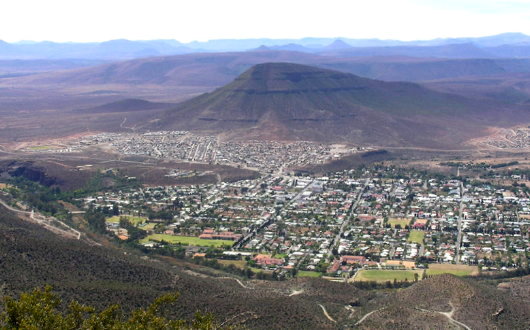
Graaff-Reinet
The Gem of the Karoo
IF YOU HEAD OUT from Cape Town making for the Valley of Desolation, you take the main road to Johannesburg, breaking ranks at the town of Beaufort-West in the Great Karoo, where you head eastwards on the R61. That road eventually joins up with the N9 (famous for its “Uniondale Ghost”) and, before you reach the Valley, takes you to the pleasant little town of Graaff-Reinet. The town was founded in 1786, making it the fourth-oldest in South Africa, after Cape Town — the “mother city” — Stellenbosch, and Swellendam. Graaff-Reinet was named in deference to the Dutch governor of the day, Cornelis Jacob van de Graeff, and his wife whose maiden name was Reynet, but the burghers earned an early reputation for rebelliousness, proclaiming their own independent republic in 1795, with further uprisings in 1799 and 1801. While now situated in the Xhosa-dominated Eastern Cape, Graaff-Reinet is predominantly Afrikaans.
The town, which rests on a bend in the Sunday’s River, has a host of architectural delights, of which my favourite is the Reinet House (below). It was built in 1812 as a parsonage for the Dutch Reformed minister, and was later part of the teacher training college until it fell vacant and was restored as a museum after the Second World War, being opened in 1956 by the Rt. Hon. E.G. Jansen, the Governor-General of the day.
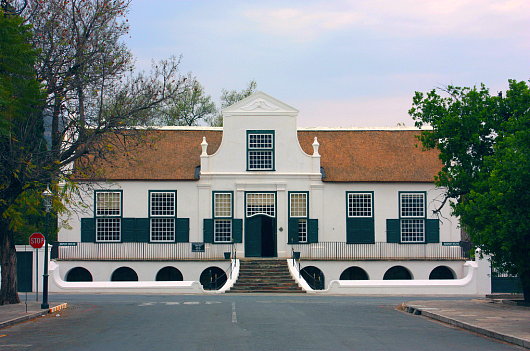
Everything about Reinet House is just right: the level of decoration, the placement of the windows, and the precision of its proportions. I enjoy especially the sweeping pair of staircases that flow down from the rear stoep. This has led some to suspect the design might be the work of Louis Michel Thibault, the greatest architect of the Cape, who is known to be responsible for the Drostdy which faces it at the other end of Pastoriestraat. I find the design of Reinet House superior to that of the Drostdy, so, as a Thibault fan, I hope he is indeed responsible for both.
But let’s use a few snaps from Google StreetView to get a better picture of the public and domestic architecture of Graaff-Reinet.
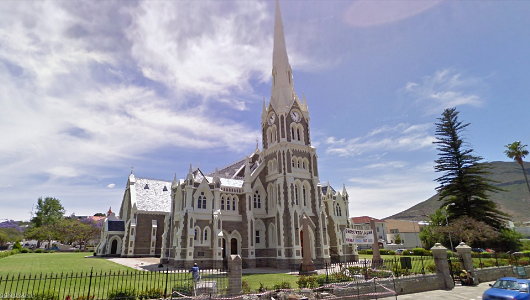
The Dutch Reformed Church undoubtedly dominates the town: it is to Graaff-Reinet what the Eiffel Tower is to Paris. Modelled on Salisbury Cathedral, it’s an interesting local take on Victorian Gothic; handsome, but not to my particular taste.
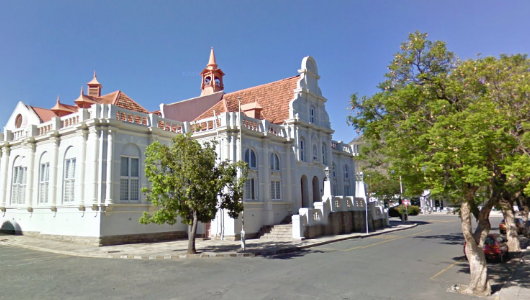
Behind the Church is the Stadsaal, or City Hall: a splendid Cape Dutch Revival building. If its colouring were more exuberant, one could almost imagine it in Willemstad or Oranjestad in the Dutch Caribbean.
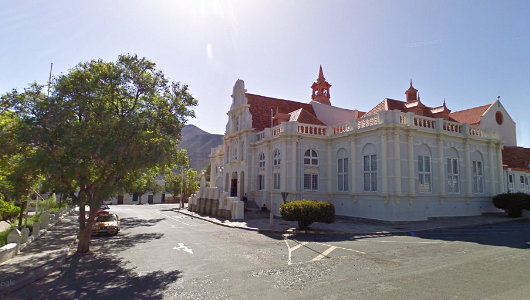
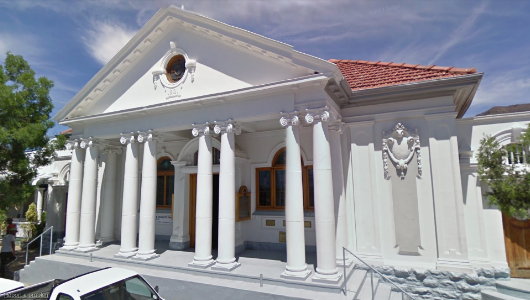
Irritatingly, I can’t find out what this building is. I’d be happy to be enlightened on that.
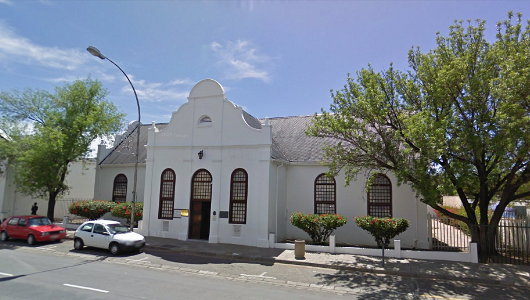
Built as a Dutch Reformed Mission Church in 1821, this building was about to be demolished and replaced by a Total petrol station in 1965. Anton Rupert, the enterprising businessman and founder of the Rembrandt Group, was born in Graaff-Reinet and didn’t want to see the building destroyed. Annemarie Van Zyl supplied this telling of the story to the Bulletin of the Volksboukundige Vereniging van Suid-Afrika:
Anton Rupert intervened personally, offering to buy back the church from Total. He took the matter to their head office where he resorted to some gentle blackmail when he realised that he was getting nowhere. He apparently suggested that it would be a shame if all the hundreds of Rembrandt reps on the road those days never filled up at a Total station again, and that sealed the deal!
The old church was turned into an art museum which Rupert had donated in trust to the town of Graaff-Reinet, who in turn named it the Hester Rupert Art Museum after the donor’s mother.
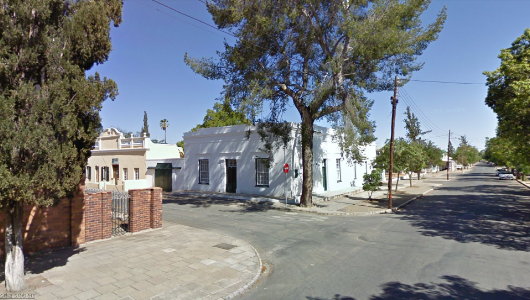
While the town’s public buildings are significant, Graaff-Reinet’s domestic architecture is worth exploring. This house (at the corner of Bourke & Muller) is almost the perfect archetype of a humble but stately town house in the Cape Classical style.
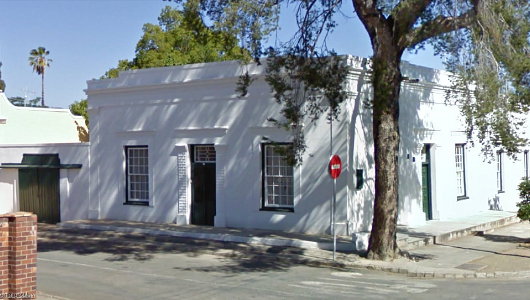
It’s simplicity and symmetry are admirable, and it employs just enough ornamentation to make it immensely dignified.
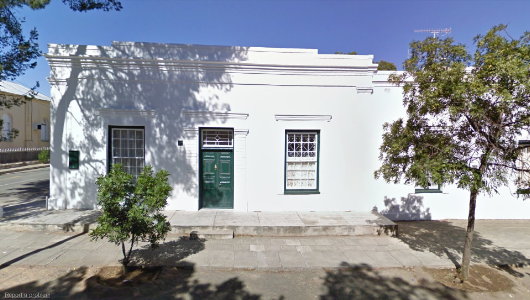
Houses like this should have been the paradigm for the house-building programs introduced by the ANC government in the past fifteen years, especially in the Cape. Sadly, the government instead preferred to replace the shantytowns with dull astylar homes such as in Cape Town’s N2 Gateway.
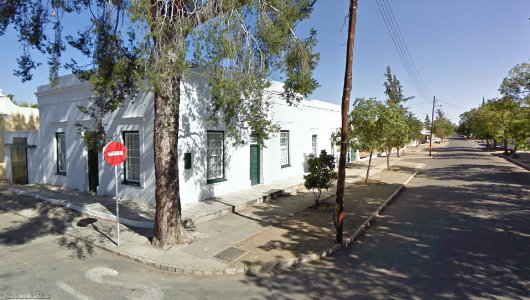
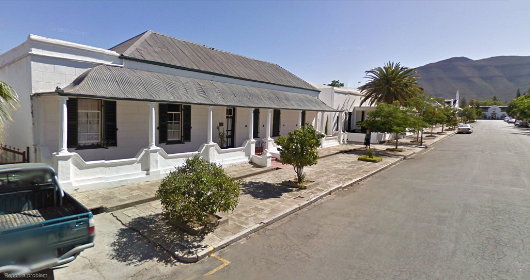
When many of the farmers and dorpies began to replace their roofs of thatch with corrugated tin, it became popular to introduce a sinuous bend to the material when using it to cover over a stoep. The effect is welcome, and gives a certain Regency air.
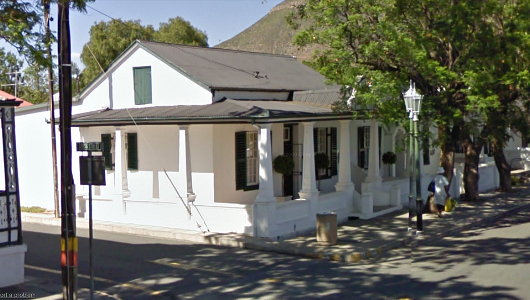
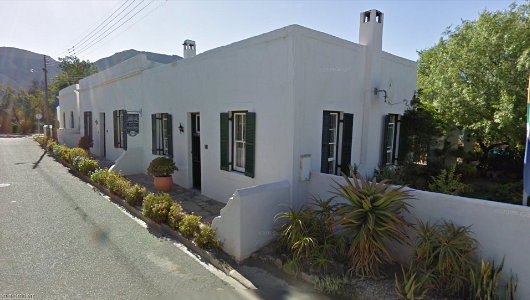
The stoep is possibly the most significant contribution of Cape architecture. It can be found in front of the grandest country house or the humblest town residence, usually with a little seating delineating either end of the stoep’s domain.
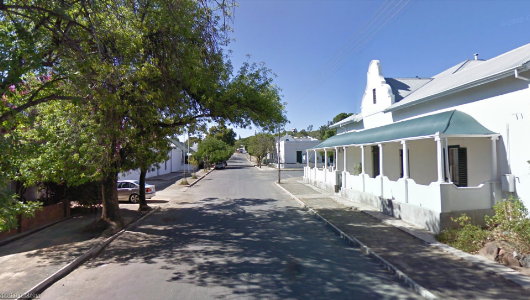
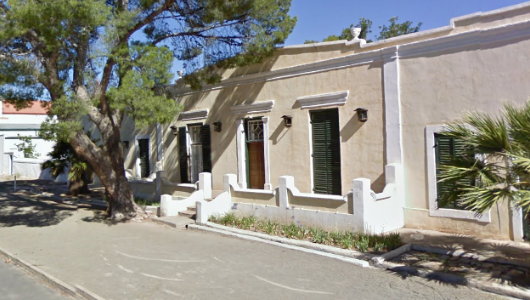
There you can rest and wave hello to your neighbours as they pass on their late afternoon walk, perhaps tarrying awhile and giving the latest town news.
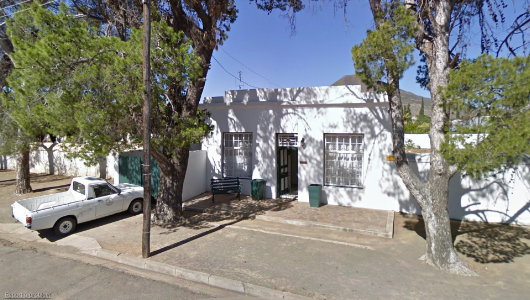
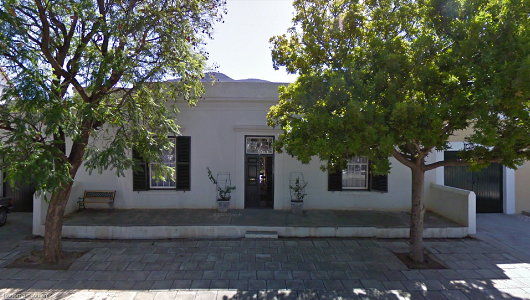
Trees, or the lack thereof, can often make or break a thoroughfare, whether a grand boulevard or a little steeg or alleyway.
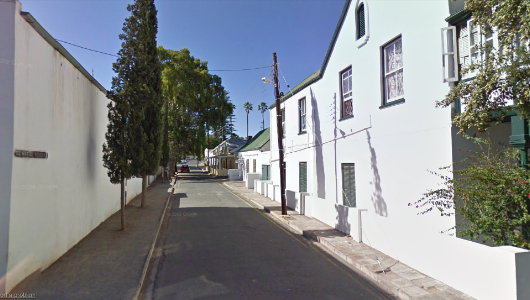
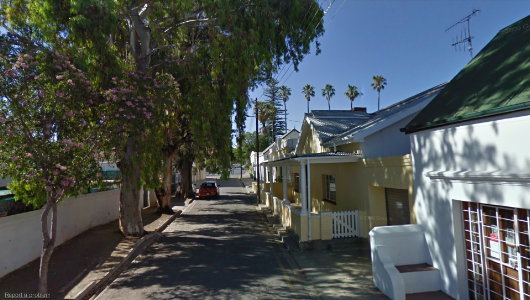
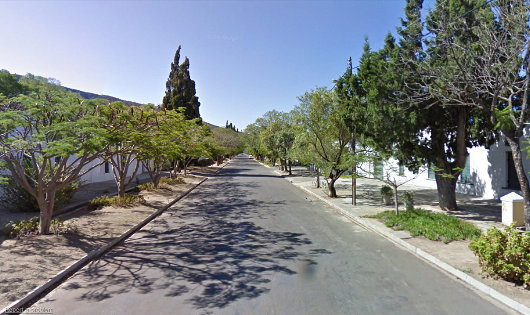
So tot siens to Graaff-Reinet. Worth an exploration if you’re in the area, wouldn’t you say?
Search
Instagram: @andcusack
Click here for my Instagram photos.Most Recent Posts
- Burns Tower April 19, 2024
- Patrick in Parliament March 18, 2024
- Articles of Note: 13 March 2024 March 13, 2024
- Cambridge March 9, 2024
- Taken on Trust March 4, 2024
Most Recent Comments
Book Wishlist
Monthly Archives
Categories



Andrew …
This is one of my favourite places in South Africa. The first time I visited here I was a young lad with my parents and we sadly only passed through. But I remembered it, and came back by myself years later. I stayed at the Drostdy Hotel, built by the Dutch colonial government in 1806. In my opinion, a perfect hotel, and happily the restaurant had a number of “Boerekos” classics. I walked about the streets of the town, down many of the same in your photos above. If you hike up the “kopie” overlooking the town on the west side you get a magnificent view of the region, and you can see the almost perfect circular shape (like a “laager”) of the old constructed town. Readers should note that you can also take a tour of Graaf Reinet with Google Maps Streetview. I find Graaf Reinet a magnificent and graceful approach to the Karoo if you drive the stunning highway from the north to the Cape. But I was gobsmacked by a comment of a South African compatriot who asked me “What the bladdy hell do you want to go out that gramadoeloes of a plekkie!?” There is just no accounting for taste, I reckon … watookal!
Groete …
Andrew …
It appears the building that you query in the photos above is 14 Kerkstraat and is occupied by Derckensen & Partners. If you look at it in Google Maps Streetview you can see that it was constructed in 1921 and you can see part of the sign of the occupants on the front of the building.
Hope that helps …
It might interest some of your readers to know that the van de Graaff family (the name is now so spelled) continues to flourish. Cornelis Jacob’s own branch died out with his last surviving granddaughter in 1881, but other branches continue in positions of prominence in the Netherlands and, interestingly the USA. The American branch’s most distinguished member was Robert Jemison van de Graaff, a professor of physics at both Princeton and MIT, and the developer of the Van de Graaff generator. His birthplace, the Jemison Van de Graaff mansion in Tuscaloosa, Alabama, would be worthy of one of Mr Cusack’s beguiling and informative postings.
The Dutch in modern times will also remember Volkert van de Graaf as the assassin of Dutch populist Pim Fortuyn. I have no idea if this branch of the family has anything to do with Cornelis Jacob van de Graeff or any of his descendants in the New World, southern Africa, or here in The Netherlands.
The wretched fellow is correctly named Volkert van DER Graaf, and there is no connection at all between his family and the historically eminent van de Graaff family.
A full genealogy will be found in Nederland’s Patriciaat, volume 74 (1990).
Sorry for that error. Indeed, he is a wretched creature. After seeing the above correction I did a cursory check of Web references to confirm my spelling error. I am now happy to feel that this special place in South Africa is untainted by that unhappy event in recent history.
I am delighted to have been a source of enlightenment, Mr Cooper. A cousin of mine married into the Van de Graaff family; thus both my interest and my subsequent knowledge.
Bravo! to Anton Rupert. I wish we had people with such ingenuity and power to save our threatened landmarks. By the way the town looks lovely, but when I read about heading out of Cape Town for the Valley of Desolation, I couldn’t help but wonder why anyone would WANT to go to the Valley of Desolation.
I too visited Graaff-Reniet as a young child and have never forgotten the place. We camped in the caravan park and I can still taste the Karoo lamb chops my father braaied. Of course, the place was unselfconscious then. It was just ‘town’.
Years later, I rode a motorbike through the eeriest, stark granite hills approaching Graaff-Reniet from Port Elizabeth via Uitenhague. I suppose it must have been the Valley of Desolation.
Very nice town and such charm. From the looks of it and those palm trees in the background, it could very well be Los Angeles or at least the wider American Southwest. Quite interesting.
Matt
I am pleased you enjoyed Graaff Reinet so many years ago. I came across you site while looking for information for my own posts. I enjoy the town very much, and have done so since I was a child. Even though I live in London now I remember it vividly and have more than enjoyed my visits in the past two years.